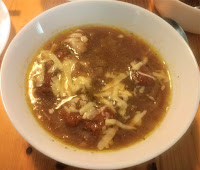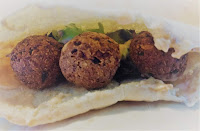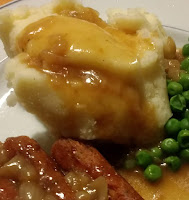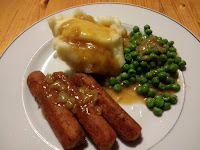 |
| Vegetable Lasagne |
There's no need for it to be like that. I don't use aubergine - it's best left for ratatouille, and not used as a bizarre 'meat substitute'. Why is it that so many chefs seem to think that vegetarian cooking needs something to take the place of the meat? This is vegetable lasagne, not vegetarian. It happens to be vegetarian, but it's a dish made with vegetables, not a vegetarian equivalent of a meat dish.
Making lasagne is a bit of an undertaking and you need to take your time. It's not difficult, but there are a few stages and it's worth the wait.
You'll also note that there are no onions. In the UK we seem to think that tomato sauces invariably need onions. Sometimes that's good, other times not so much. Lots of proper Italian sauces don't include onion. I don't make any claims of this being in any way authentically Italian; it's the way my family like lasagne, not the way it 'should' be made. I even grate Cheddar on the top - no Italian would do that. But cook however you like; there are no rules really. You can use different vegetables - sometimes I use a bit of brocolli, cut up small, and mushrooms. But anything will do, even aubergine!
This is enough for a good helping for a couple of people. Have it with garlic bread - you can make it yourself but you probably won't want to, so either buy the frozen or chilled stuff or put garlic butter in a part-baked baguette for the "made it myself" feeling without the hassle. A bit of salad on the side with a balsamic vinegar dressing might be nice too. No frozen chips...
Ingredients
For the tomato sauce
- A splash of olive oil
- A clove of garlic
- Three or Four medium sized mushrooms
- Half a courgette, or a whole little one
- About an inch off one of those nice pointy sweet red peppers
- A tin of nice chopped tomatoes
- A squirt of tomato puree
- A pinch of chilli flakes
- Some fresh basil, or dried if you haven't got it
- Sea salt or black pepper to season
For the white sauce
- A good glug of olive oil
- A heaped tablespoon and a half or so of plain flour
- About half a pint of milk; semi skimmed is fine
- Grated nutmeg
To finish
- Lasagne slices
- Cheese to top
- Dried oregano
Tips
Sometimes I make this with fresh tomatoes if they're plentiful, really ripe and cheap enough. But you need loads, and making a passata first is a right hassle. Honestly, chopped tomatoes in a tin are plenty good enough, and for lots of the year, better. Buy nice ones though - Napolina are really good but expensive, Cook Italia are nice and much cheaper but harder to get. The Lidl ones are OK, but buy the "Freshona" ones not "Simply". They're definitely worth the extra 3p! You can use whole tinned tomatoes but chop them up in the tin first, plus they'll need to cook for longer because there's more juice.
As usual, I'll say that the tomato sauce needs plenty of cooking. If you don't simmer tomato sauces for quite a long time they are sharp and acidic but cook for long enough and the tomatoes go nice and sweet. A bit of salt helps with this, oddly. I've seen a few recipes which suggest putting a bit of sugar in. I wouldn't; just cook for longer, and don't use rubbish tomatoes.
A lot of people struggle with a roux, or white sauce. There are as many ways of doing it as there are people cooking I reckon, but the way I make the sauce is pretty foolproof. The olive oil instead of butter makes it lighter. You do need good extra virgin olive oil though. Lidl is fine, Cypressa is good too, and great value. I find the branded ones are fine but overpriced for what they are.
Grated mature cheddar is my topping of choice. Equally you can use Parmigiana Reggiano (parmesan) or one of the other Italian hard cheeses, but be sparing with it or mix it with cheddar. Slices of Mozzarella would work too.
You need a lasagne dish to cook this in. Not too deep and preferably as square as you can get it, because it makes the assembly much easier.
Method
Make the tomato sauce first. Put enough olive oil in a medium sized saucepan to cover the bottom. Peel the garlic, crush with the knife and finely chop. Slice the courgette into rounds, cut the manky bottom of the stalks off the mushrooms and slice. Cut the pepper into very fine strips - you want it to disappear in the sauce. The courgettes should be nice and thin; the mushrooms a bit chunkier.
Put the heat on, put all the vegetables in the saucepan, add a pinch of sea salt and stir. When they start to sizzle, turn the heat down to quite low and put the lid on. Leave it for a while, stirring occasionally and adjusting the heat if necessary. You want the courgettes to look pretty much cooked but still whole.
Add the tin of tomatoes and swill the tin round with a bit of water and add that too. Squeeze in a good squirt of tomato puree and add a small pinch of chilli flakes. Be sparing; you don't want it to taste spicy as such, but a little bit of chilli just lifts it a bit. If you're using dried basil now is a good time to add that too. Give it a twist of pepper now, but not too much - you can add more later but you can't take it away. Bring it to the boil, stir, turn down to a low boil (not quite as low as a simmer) and put the lid on and leave it. Return to stir occasionally.
You'll know when the tomato sauce is nearly ready - it'll thicken a bit and the lumps of tomato will pretty much have gone away. Taste it, adjust the seasoning and add some chopped fresh basil if that's what you've got. Put the lid back on and turn it down a bit more until you've finished making the white sauce. It won't take long. Put the oven on - 180 is about right for a fan oven, but if you're cooking garlic bread too then whatever it says on the packet.
Make the white sauce. Put some olive oil in a small saucepan. Quite a bit - difficult to say how much but you'll need it to be runny enough once you've added the flour. You can always add a bit more. Put the heat on full, add the flour and stir with a wooden spoon. It should look a bit like grease, but not too thick. Stir until it starts bubbling; turn down and leave to cook for a minute or so. Take the pan off the heat and, using a balloon whisk, whisk in a decent splash of milk. Put it back on the heat, turn up to high and keep whisking. As it gets towards boiling it will suddenly thicken, hopefully becoming too thick. At this point whisk in a bit more milk. You can leave it on the heat to do this, just tip a bit in as you're whisking. The idea is to keep adding milk in little splashes until it reaches the right thickness. The right viscosity is about that of a thick gravy - it'll thicken a bit more when it goes in the oven so don't overdo it. It doesn't matter if the sauce boils a little while you're doing this. Once you've got the consistency right take it off the heat and stir in a bit of grated nutmeg.
Now assemble the dish. The 'right' way is alternating layers, but I prefer white sauce on the bottom and top. No need to grease the dish. Put half of the white sauce in the dish and spread it out evenly with the back of the spoon. Put a layer of lasagne sheets on top. You want it to be as close as possible to one complete layer - break it to fit, and try not to overlap it too much because it will be a bit chewy if you do. Then add half the tomato sauce, another layer of lasagne, the other half ot the tomato sauce, lasagne and the rest of the white sauce on top. Grate cheese evenly over the top, sprinkle oregano evenly over that and bake for about 25 minutes, until the cheese is a bit brown and you can see the sauce boiling around the edge.
Once the lasagne is cooked, take it out of the oven and leave it for a minute or two so that it isn't too hot to handle. Now is a good time to dress a salad or slice some garlic bread. Cut through the lasagne with a big sharp knife, free off the edges and get it out of the dish with a fish slice. That way it'll keep its shape, and you can feel clever like I always do when it works and doesn't just go in a big heap on the plate.
I hope you like it - better than a pub lasagne.





